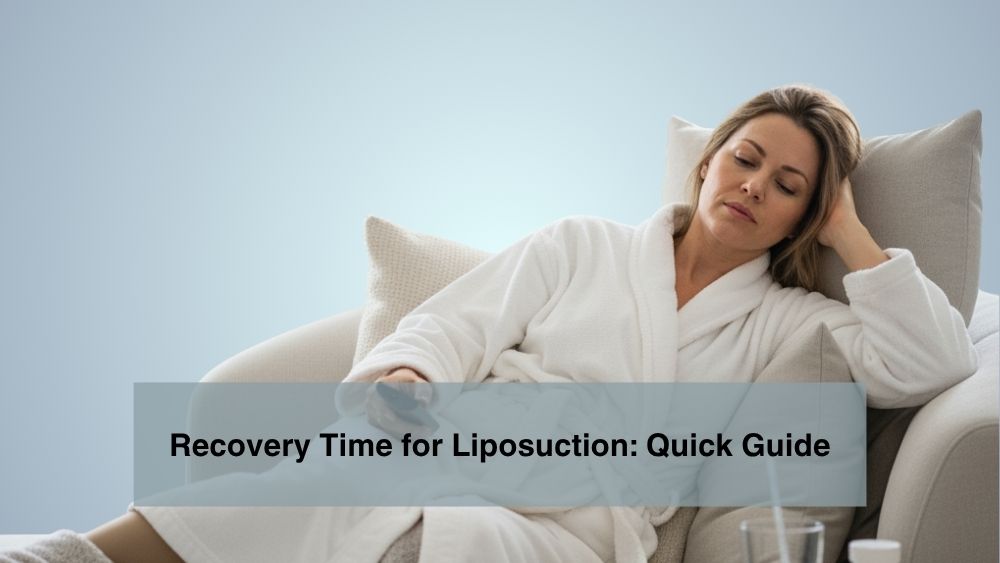Recovery Time for Liposuction: Quick Guide

Every patient considering recovery time for liposuction wants to know exactly how long it takes to bounce back. In this article, we’ll walk through the full liposuction procedure, the liposuction recovery timeline, what affects healing, and expert tips for achieving your best outcome.
Table of Contents
ToggleIntroduction to Liposuction Surgery
Liposuction surgery is a cosmetic surgical procedure designed to remove excess fat and sculpt the body shape. That said, knowing the recovery time for liposuction is vital, understanding what happens in the first few weeks through four to six weeks and beyond helps you prepare physically and mentally.
A qualified board certified plastic surgeon can help you choose which liposuction option fits your goals, explain risks, and guide you through the recovery process so your body can heal properly.
Types of Liposuction
There are several types of liposuction procedures, and each has its own technique and recovery characteristics. The most common include tumescent liposuction, power-assisted liposuction, and laser-assisted liposuction. A board-certified plastic surgeon will recommend the best option based on your goals, body type, and how much fat is removed.
Tumescent liposuction
Remains the traditional and most widely used approach. It involves injecting a special tumescent fluid, a mixture of saline, lidocaine, and epinephrine, into the treatment area. This fluid numbs the region, minimizes bleeding, and makes it easier to remove fat cells through suction. Because of its safety and precision, it’s often chosen for outpatient procedures and has a predictable recovery timeline.
Power-assisted liposuction (PAL)
Uses a small vibrating cannula to break up stubborn fat deposits more efficiently. This vibration allows the surgeon to move the cannula smoothly and remove excess fat with less trauma to surrounding tissues. PAL is especially effective for larger areas such as the lower abdomen or thighs, and it may lead to a shorter recovery time compared with traditional techniques.
Laser-assisted liposuction (LAL)
Sometimes called SmartLipo, uses laser energy to liquefy fat cells before they are suctioned out. The heat generated by the laser can also stimulate skin tightening, making this option appealing for patients with mild loose skin. Because it causes less trauma to blood vessels and connective tissue, laser-assisted liposuction may also help reduce swelling and shorten the recovery process for some patients.
Each technique achieves the same goal, to remove unwanted fat and refine body shape, but the ideal method depends on your anatomy, desired results, and recovery preferences. During your consultation, your plastic surgeon will explain which technique is most suitable for your needs and discuss the recovery time for liposuction based on your chosen approach.
The Liposuction Procedure
Here’s what typically happens during liposuction surgery:
- Anesthesia is administered, either local, sedation, or general anesthesia, depending on the extent of the procedure.
- Small incisions are made in the incision site (often inconspicuous).
- A thin tube called a cannula is inserted to break up fat cells and suction them out.
- The fat removed is measured; your surgeon ensures symmetry and smooth contour.
- Compression garments may be immediately applied to the treated area.
- You’ll recover in a recovery room (monitoring) before being discharged or staying overnight if needed.
Many liposuction procedures are done as an outpatient procedure, meaning you go home the same day.
Immediate Post-Procedure Care
Right after surgery, your body begins the liposuction recovery:
- You will be observed in a recovery room to monitor vital signs and initial healing.
- Expect swelling and bruising around the surgical sites.
- Your plastic surgeon will prescribe pain medication for comfort.
- Compression garments are essential, they help reduce swelling and encourage skin to conform.
- Light walking is encouraged as soon as possible to promote blood flow and reduce risks of blood clots.
- Avoid strenuous activity, bending, or heavy lifting.
Follow all post operative care instructions to support proper healing and minimize complications.
Understanding Liposuction Recovery
The recovery process after liposuction is gradual. Key points:
- Swelling and bruising are normal responses to trauma and fluid shifts.
- The body slowly absorbs residual fluid and heals damaged tissue.
- You may feel firm or “woody” swelling in week 2–3.
- Residual swelling can take up to six months to fully resolve.
- Final body contour becomes evident over time as tissues settle.
Patience is key: healing happens at your own pace, but consistent care accelerates it.
Liposuction Recovery Time
Here’s a day by day liposuction recovery breakdown of what to expect in your liposuction recovery timeline:
Days 1–7 (First Few Days)
- Swelling and bruising peak.
- You’ll feel soreness and may see some drainage from small incisions.
- Light walking is encouraged (not strenuous) to prevent blood clots.
- Compression garments must be worn continuously.
Days 8–14 (Week 2)
- Swelling may persist or slightly increase (common).
- Pain should decrease; pain medication usage tapers.
- Many most patients can return to desk work if comfortable.
- Still avoid strenuous tasks or bending.
Weeks 3–4
- Swelling begins to soften and diminish.
- You may switch the compression garment wearing schedule (some part-time).
- Begin moderate exercise like slow walks; avoid vigorous activity.
Weeks 4–6
- Most residual swelling resolves significantly.
- Many surgeons allow return to a more regular exercise routine (light cardio) with caution.
- By week six, you should see a clearer body shape emerging.
Months 3–6+
- Fine-tuning of results; final contour often appears by six months.
- Some minimal swelling may linger up to six months.
- The skin continues remodeling; some loose skin might remain.
- Vigorous workouts or full athletic activity typically resume after clearance by your plastic surgeon.
Of course, this timeline is approximate—your recovery time depends on many factors (discussed below).
Final Liposuction Recovery Insights
Your healing will depend on several key factors that influence how your body responds after surgery.
The first is how much fat is removed and how many areas are treated during the procedure. Larger treatment zones or greater fat removal may naturally require a longer recovery period.
The specific liposuction technique used, whether tumescent, power-assisted, or laser-assisted, also affects healing time and post-surgical comfort.
Your overall health, age, and skin elasticity play important roles too, as they determine how quickly tissues repair and tighten.
Following your surgeon’s postoperative instructions, wearing compression garments, getting enough rest, and avoiding smoking, greatly improves your recovery process.
If liposuction is combined with other plastic surgery procedures, such as a tummy tuck, expect a longer recovery since your body will need more time to heal.
Lastly, complications like blood clots, poor blood flow, or infection can delay progress, making careful monitoring essential. A board-certified plastic surgeon will evaluate all these factors and create a personalized plan to help you recover safely and effectively.
Managing Pain and Discomfort
Pain after liposuction is expected, but it’s usually manageable with the right care.
Take your prescribed pain medication exactly as instructed by your surgeon to stay comfortable and avoid unnecessary discomfort.
If you experience soreness at night, try elevating the treated area, this can help reduce pressure and ease swelling. Applying ice or cold compresses for short periods, as recommended by your surgeon, can also help reduce swelling and provide relief.
Incorporate gentle movement, stretching, and light walking into your routine to improve circulation and minimize stiffness. These small actions promote healing and help prevent blood clots.
Avoid pushing through pain or overexerting yourself, rest is an essential part of recovery. Taking too much or too little pain medication can slow progress, so follow your surgeon’s advice closely and reach out if discomfort continues longer than expected.
Fast Tips for a Smooth Recovery
Here are strategies to expedite healing and support proper recovery:
- Wear compression garments diligently, especially in the first 4–6 weeks.
- Begin light walking early to stimulate blood flow and reduce risk of blood clots.
- Stay hydrated and follow a balanced diet rich in protein, vitamins, and minerals.
- Avoid strenuous activity or heavy lifting until cleared by your plastic surgeon.
- Take prescribed medication (antibiotics, pain relief) as directed.
- Monitor incision sites for signs of infection and keep them clean.
- Sleep with treated areas slightly elevated when possible.
- Be patient—healing takes time, and controlling swelling and bruising is part of the journey.
- Attend all follow-up visits to detect and manage any post operative side effects early.
Understanding the recovery time for liposuction helps you set expectations and prepare your body for optimal healing. While some return to light activity in a week or two, full recovery and final results often take up to six months.
Working with a board-certified plastic surgeon, following postoperative instructions, and caring for your body during the liposuction recovery timeline are the keys to safe, satisfying results.
Recovery Time for Liposuction FAQs
Does insurance cover liposuction?
In general, no, most insurance plans consider liposuction an elective cosmetic procedure and do not cover it. However, coverage may be possible in rare cases when the procedure is medically necessary (for example, treatment of Lipedema, post-burn fat-transfer needs, or fat removal required before a major surgery). lafemmeps.com
What is the average recovery time for liposuction?
Most patients see significant improvement within three to six weeks, though full healing and resolution of swelling can take up to six months. During this time, the skin gradually tightens and adjusts to the new contours of your body. Consistent use of compression garments and a healthy lifestyle can further enhance your final results and help maintain a smooth, sculpted appearance.
When can I resume exercise after liposuction?
You can typically begin light walking within days. Moderate exercise may resume around week 4 to 6, while vigorous exercise waits until six months or as cleared by your plastic surgeon. Consistent follow-up with your surgeon ensures you progress safely through each recovery phase.
How much fat can liposuction safely remove?
The safe amount varies by patient, surgeon, and technique. A skilled plastic surgeon will assess your own pace and health to determine how much excess fat can be removed without risking complications. Removing too much fat at once can increase risks like fluid imbalance or contour irregularities.
Why does swelling last so long after liposuction?
Swelling is a natural part of healing: the body needs time to absorb residual fluid, repair blood vessels, and remodel tissues. In some areas, residual swelling may persist for months. Wearing compression garments and maintaining hydration can help minimize prolonged swelling.
Can liposuction cause blood clots?
Yes, blood clots and deep vein thrombosis (DVT) are rare but serious risks. Early mobility, compression, and follow-up care are essential to prevent this complication. Surgeons often recommend specific preventive measures depending on your personal risk factors.
Does liposuction tighten loose skin?
Liposuction removes fat cells, but it does not reliably tighten loose skin. In cases of poor skin elasticity, your surgeon may recommend combining it with a tummy tuck for better contour. Some newer liposuction techniques can slightly improve skin firmness, but results vary by individual.
Schedule Your Liposuction Consultation with Dr. Mason
Liposuction can effectively remove fat cells and sculpt a more balanced body contour, especially for patients with a modest to moderate amount of fat to lose. If you have a larger amount of fat to reduce, your surgeon may recommend reaching a stable weight before the procedure to ensure the best results.
Find out whether you’re a good candidate by contacting our office today and scheduling your consultation with board-certified plastic surgeon Dr. Rachel Mason. She’ll discuss your goals, evaluate your options, and create a plan tailored to your body and desired outcome.


